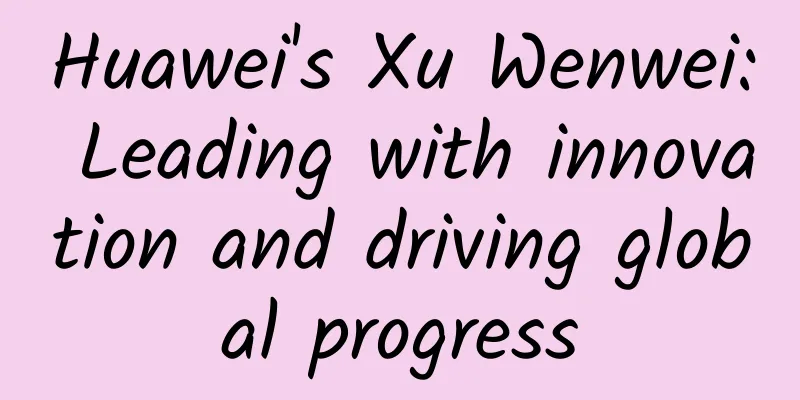Huawei's Xu Wenwei: Leading with innovation and driving global progress

|
On April 16, at the 16th Global Analyst Conference held by Huawei with the theme of "Building a Fully Connected Intelligent World", Xu Wenwei, Director of Huawei and Dean of the Strategic Research Institute, announced that Huawei is moving towards the Innovation 2.0 era based on vision-driven theoretical breakthroughs and basic technology inventions, and announced the establishment of the Strategic Research Institute. The following is a transcript of Xu Wenwei's speech: Hello everyone, thank you for attending the 16th Analyst Conference. Every April, you come as scheduled, gather in Shenzhen, and witness the changes in Huawei in the past year with us, and sincerely communicate and share your views. After more than 30 years of hard work and technological innovation, we have rowed Huawei to the "starting line in sync with the world". Today, we are standing at a new starting point, which means an upgrade of Huawei's innovation strategy. At the same time, it also means that we will make more contributions to promoting world progress. Over the past 30 years, the root cause of Huawei's product leadership lies in engineering and technological innovation based on customer needs. Looking to the future, Huawei will increase investment in basic technology research and theoretical research based on the dual-wheel drive of vision and customer needs. Explore the future, illuminate the world, illuminate Huawei, and realize the innovation strategy of technological leadership. The times call for theoretical breakthroughs
As we all know, after more than 50 years of rapid development of the information industry, both the theoretical and industrial circles have begun to encounter development bottlenecks. 1. The first is the theoretical bottleneck: current innovation mainly involves implementing theoretical achievements from decades ago through technology and engineering. For example, Shannon's law was published 70 years ago in 1948. In the 5G era, it has almost reached the limit of Shannon's law. CDMA was invented by actress Hedy Lamarr in 1941. The development of the ICT industry has encountered a bottleneck and requires new theoretical breakthroughs and the invention of basic technologies. 2. The second is the engineering bottleneck: Moore's Law has driven the development of ICT. Previously, (CPU) performance increased by 1.5 times each year, but now it can only reach 1.1 times. How will Moore's Law develop next? These are the bottlenecks we encounter in the development of ICT. 3. As for Huawei itself, Mr. Ren pointed out in 2017 that Huawei's current innovation is still at the engineering level of engineering mathematics and physical algorithms. Looking to the future, Huawei feels confused and lost. What will Huawei do next to break through these bottlenecks? Huawei's innovation concept upgrade: from 1 to N to from 0 to 1 In response to the bottlenecks and challenges in the industry, Huawei's innovation strategy is to move from the 1.0 era of technology and engineering innovation based on customer needs to the 2.0 era of innovation based on vision-driven theoretical breakthroughs and basic technology inventions. The core concept of Innovation 1.0 is: based on customer needs and challenges, it is technological innovation, engineering innovation, innovation of products and solutions, and innovation from 1 to N. The core is to help customers and partners enhance their competitiveness, help customers increase revenue or reduce costs, and help customers achieve business success. In the past, Huawei has made a lot of engineering and technological innovations in the fields of wireless, optical networks, and smartphones, which have brought great business value to customers and created huge social value. The core concept of Innovation 2.0 is: based on the assumptions and vision of the future intelligent society, it breaks the theoretical and basic technology bottlenecks that restrict the development of ICT. It is an innovation that achieves theoretical breakthroughs and basic technology inventions, and it is an innovation that achieves innovation from 0 to 1. There is no secret to Huawei's success. It is the result of 30 years of R&D investment of over 100 billion US dollars, and the natural return of the value brought to customers by Innovation 1.0. Let me share a few cases below. From AII IP, All Cloud to All Intelligence: Driving the Development Direction of the Industry First, Huawei has insight into and grasped the general direction of the industry and formulated a correct network development strategy; the correct general direction not only ensures that product research and development does not take detours, but also ensures that products are at the forefront of the industry and guide the development direction of the industry. For example, In 2005, we pushed the network architecture towards ALL IP and formulated the Single strategy, turning multiple networks with coexisting switching technologies such as TDM, ATM, and FR into a single network based on IP switching. We formulated a four-step strategy of "IP-based interfaces, IP-based cores, IP-based architectures, and IP-based services". Today, a unified IP-based network has increased the end-to-end construction cost and operating efficiency of operators by 3-4 times. In 2011, we judged that cloud technology would have a significant impact on the network, promoted "ALL Cloud", and formulated the SoftCOM (Software defined + TeleCOM) network development strategy, which is to use the concept and technology of cloud computing to transform the telecommunications network, and realize "software defined networks" through "resource pooling, software distribution, and operation automation" to build an open and agile network. The efficiency of service deployment and service issuance has been increased by more than double. In 2016, we believed that AI, as a general technology, would be everywhere, and proposed the concept of ALL intelligence. Therefore, based on SoftCOM, we introduced AI into the telecommunications network and proposed the development goal of "autonomous driving network", which completely changed the operation and maintenance mode of the telecommunications network and gradually realized the "unattended" network. Ultimately, we structurally solved the problem of high network Opex and slow service provisioning of operators, and the goal was to achieve automation of 80-90% of network operation and maintenance work. With a clear and accurate network architecture development strategy, *** Company continues to move in the right direction and continues to be at the forefront of the industry. From distributed base stations to generationless evolution, *** new direction of wireless development In terms of product and solution innovation, Huawei's innovation is not only in all aspects of various product areas, but also continues to innovate in leading industries, such as In the wireless field, as early as 2005, Huawei developed the industry's first distributed base station. In 2007, it took the lead in launching the SingleRAN base station, integrating 2G and 3G base stations. The value of these series of innovations is not only to reduce TCO by 30%, but also to greatly lower the threshold for network construction and make the entire process of network construction simpler. Huawei's leadership in wireless is the inevitable result of long-term and continuous technological and engineering innovation. From OTN to All-Optical Network: Defining New Standards for Optical Networks Huawei's innovation is not only in the wireless field, but also in the optical field. From OTN to all-optical networks, Huawei is a leader in industry standards. For example, Huawei's OXC (optical switching) system replaces the traditional 3,000 optical fibers with an optical backplane, and uses optoelectronic integration to replace the original cabinet with a single board. This has brought huge value to customers, not only reducing power consumption by 50%, reducing floor space by 90%, but also improving deployment and operation efficiency by a hundred times. From multiple cameras to smart chips, setting a new benchmark for mobile phones Of course, we cannot talk about innovation without talking about Huawei phones. Huawei is the first manufacturer to release a dual-camera phone. The recently released P30 phone not only realizes the combination of four cameras, setting a new benchmark for photography, but also the reasons behind these features: micron-level folded optical path design, 10X hybrid zoom performance, 0.00024-degree separate dual OIS anti-shake, a R&D team of more than 300 people, and 36 months of careful polishing. Huawei is also the first manufacturer to introduce AI into mobile phones, making mobile phones "user-centric", creating mobile phones that understand you, and pushing mobile phones from "intelligent" to "smart" phones; The most popular is Huawei's folding phone MateX, which has a hinge and is the result of innovations in multiple disciplines such as mathematics, materials, mechanics, and design. It took three years of research and dozens of iterations to finally achieve 200,000 stable operations, thus ensuring the flatness of the entire phone. You can see the product, but you can’t see the technology behind it. What we see is the product, but the technology under the hood is the real competitiveness. Mathematics, chip design, materials, heat dissipation, etc., these are the basic capabilities behind it. Huawei has more than 60 basic technology laboratories, more than 700 mathematics PhDs, and more than 200 physics and chemistry PhDs; breakthroughs in mathematical algorithms determined the birth of SingleRAN. As early as 1991, Huawei designed the first ASIC chip and established a chip design studio. Nearly 30 years of accumulation and research on material corrosion resistance have enabled Huawei products to adapt to various environments. Research on graphene has greatly improved the heat dissipation efficiency of batteries; the fanless heat dissipation design has reduced the volume of base stations by 30%... Without the revolutionary changes brought about by theoretical breakthroughs and basic technological inventions, there would be no industrial development and Huawei's future success. Innovation 2.0: Vision-driven theoretical breakthroughs and basic technological inventions The above cases are all engineering and technological innovations based on customer needs, which is Innovation 1.0. The root cause of the bottleneck encountered by the industry today is the lag in theoretical innovation. Without theoretical innovation, it is difficult to break through the bottleneck of technology. To adapt to the requirements of the times, Huawei will move from Innovation 1.0 to Innovation 2.0. With open innovation and inclusive development as the concept So, what is Huawei Innovation 2.0? The core of Innovation 2.0 is the theoretical breakthrough and invention of basic technology based on vision. One of the sources of theoretical breakthrough and basic technology invention is academia. The challenges raised by the industry and the investment in research in universities are boosters. The uncertainty of theoretical breakthrough and technological invention is very high. The nature of this uncertainty determines that it cannot be a closed innovation. It is necessary to share the results and capabilities together. The idea of Huawei's Innovation 2.0 is "open innovation and inclusive development". Universities and research institutions, academia, and industry have joined forces to promote it together. University cooperation and technology investment as strategic initiatives How to make Innovation 2.0 truly come to fruition? We will adopt various methods such as "supporting university research, building our own laboratories, and multi-path technology investment" to achieve Innovation 2.0, integrate the problems of the industry, the ideas of the academic community, and the beliefs of venture capital, and innovate together. Establishment of Strategic Research Institute: Huawei establishes a strategic research institute to coordinate the implementation of Innovation 2.0 Light up the industry and the world The Strategic Research Institute is mainly responsible for the research of cutting-edge technologies for more than five years. By investing US$300 million in universities each year, it supports the academic community in conducting innovative research in basic science, basic technology, etc. The most important thing for the Strategic Research Institute is to look to the future and take on the responsibility of providing a clear roadmap for Huawei in the technology field in the next 5-10 years. Looking to the future, we will ensure that Huawei does not lose its direction and does not miss opportunities. At the same time, we will create technologies and business models that subvert the main channel to ensure the sustainable competitiveness of Huawei's main channel. We will focus on the following aspects: Basic scientific research: Huawei will set up a special fund to support basic scientific research and talent training, and promote breakthroughs in basic theories. Basic technology research: Huawei has a wealth of industry application scenarios, engineering and technical problems and major challenges faced by the industry (such as the limit of Shannon's law, the memory wall, the failure of Moore's Law, etc.). Universities and Huawei will leverage their respective advantages to promote breakthroughs in basic technologies and accelerate the research results of universities to cross the innovation death valley; Technological innovation: Jointly conduct research on current engineering and technological difficulties. The cooperation between enterprises and universities is two-way and win-win. Jointly promote theoretical breakthroughs and basic technological inventions, and the industry will create value for customers in the form of products and provide services to end consumers. Explore future technologies around the "full information process" The Strategic Research Institute studies and explores future technologies around the entire process of information, from information generation, storage, computing, transmission, presentation, to information consumption. For example, light field display in the display field, brain-like computing, DNA storage, optical computing in the computing field, visible light in the transmission field, metamaterials and atomic manufacturing in the basic materials and basic processes. Below, I will give you a few specific examples of areas where Huawei is focusing on basic research and invention, so that you can get a feel for the future of technology. Invest in optical computing and explore the development path of heterogeneous computing The first is optical computing: We know that there are more and more types of data now, and due to the limitations of Moore's Law, the cost of processing all data with one computing architecture is very high. Therefore, heterogeneous computing is one of the ways to break through Moore's Law. Huawei has invested in the research of optical computing, using the analog properties of light to realize complex logical operations in data processing. For example, in the field of artificial intelligence, 80% of the computing volume is matrix transformation, *** solution, etc. These operations are done by CPU, which is very inefficient. If optical computing is used, the performance will be improved by a hundred times, because the natural characteristics of light itself, such as diffraction, scattering, and interference, have such mathematical properties. Optical computing saves the process of large-scale digital-to-analog conversion and has a natural advantage in these specific fields. Imagine that as the amount of computing is transferred to AI, 80% of the computing volume may be more suitable for a new computing architecture, and the efficiency will be improved by a hundred times. Then, the dilemma of Moore's Law will be largely overcome. Investing in DNA storage to break the data storage capacity limit The second is DNA storage. We all know that in the information age, the amount of data is growing exponentially and cumulatively, and its growth rate is much higher than Moore's Law. Therefore, the storage capacity requirements are getting larger and larger, which will inevitably lead to increasing costs. This growth is unsustainable, and storage has become the most costly part of the IT industry. Therefore, either some data is constantly discarded or storage technology with larger capacity is sought. As we all know, genetic information is huge. A human gene has dozens of GB of information. DNA is very efficient in storing genetic information. So, can DNA be used to store information? One cubic millimeter of DNA can store 700TB of data, which is equivalent to 70 10T hard drives that are mainstream today. According to this calculation, one kilogram of DNA can store all the data today, and the capacity is amazing. The process of writing data is gene editing, and the process of reading data is gene sequencing. However, gene storage is still very far from commercial use today, because the speed of data reading and writing is still very low. For example, it takes 4 days to write 5MB of data. This requires us to explore new methods and technologies to break through these bottlenecks. Investing in atomic manufacturing to break the limits of Moore's Law The third is atomic manufacturing. Today, precision manufacturing has reached the nanometer level, such as 10 nanometers. However, this is achieved using the "macro manufacturing" method to reach the "micro size" level. Today, more precise manufacturing using macro methods is becoming increasingly difficult, which is the ceiling of Moore's Law. If we change our thinking, can we manufacture directly at the atomic scale? We can start with a single atom and assemble it directly into a nanostructure, and then assemble these nanostructures into larger micro devices. This will realize the "atom to product" manufacturing model. The size of an atom is one-tenth of a nanometer, which means that atomic manufacturing technology can improve Moore's Law by 100 times. The road to the intelligent world is long and arduous. Today, we need theoretical breakthroughs and the invention of new basic technologies. We will continue to explore the unknown new world and bravely sail into areas that have never been explored by our predecessors. Well, since we are lost, let's start ***! |
<<: Huawei's new ICT empowers enterprises to actively embrace digital transformation
Recommend
DiyVM: US CN2/Hong Kong CN2/Japan Osaka VPS monthly payment starts from 50 yuan, Hong Kong server starts from 499 yuan/month
DiyVM is a Chinese hosting company founded in 200...
5G is here. Join hands with the industry to welcome 5G large-scale commercial use
[Shenzhen, China, April 17, 2019] "5G is dev...
IoT smart home solutions create intelligent products based on scenarios
"Connected World: Smart Homes Are Key to Fut...
Misunderstood 5G antennas disguised in layers - I feel bitter but cannot express it
What do you think of when you mention 5G antennas...
After running blindly, how much money did operators make from 5G?
[[347740]] Recently, China Mobile and China Unico...
Want to know about 5G synaesthesia integration? Just read this article
Development Background Synaesthesia integration: ...
Huaxia Finance: Create an investment product that makes young people addicted
[51CTO.com original article] If someone asked wha...
What do we need to do to make IPv6 a reality?
After the General Office of the CPC Central Commi...
The three major operators may announce the commercial use of 5G messaging by the end of this year to replace SMS
Nowadays, few people send text messages except fo...
Dalian will continue to deepen cooperation with Huawei in the fields of intelligent manufacturing and service-oriented manufacturing
[51CTO.com original article] On December 22, 2016...
spinservers: 50% off China Telecom Network VPS in San Jose, China Telecom Network Dedicated Server $139/month - 2*E5-2630Lv3/64G/1.6T SSD
The tribe has shared the server information of sp...
edgeNAT newly launched Korean CN2 line native IP host monthly payment starts from 80 yuan
This month, edgeNAT launched a new Korean native ...
4 cases, a whole article of valuable information! Make your edge computing not "edge"
Edge computing means different things to differen...
Why do enterprises need a dedicated core network?
Just a few years ago, a global mobile private net...
5G plans of the three major operators in 2020
So far, the three major operators have released t...









